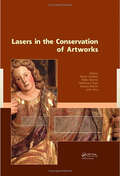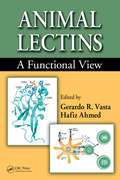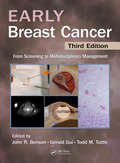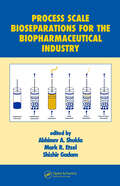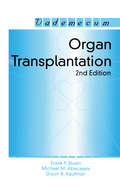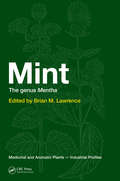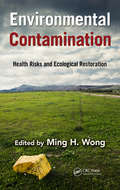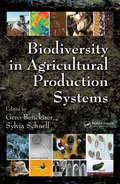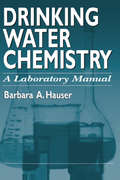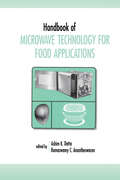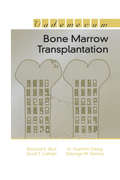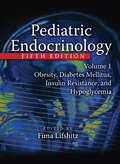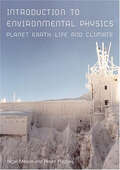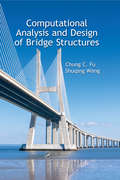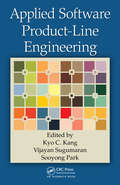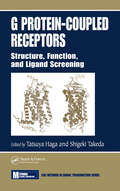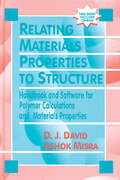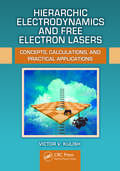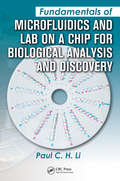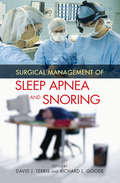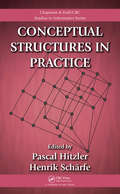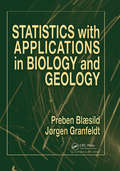- Table View
- List View
Handbook of Indigenous Foods Involving Alkaline Fermentation (Fermented Foods and Beverages Series)
by Prabir K. Sarkar M. J. Robert NoutHandbook of Indigenous Foods Involving Alkaline Fermentation details the basic approaches of alkaline fermentation, provides a brief history, and offers an overview of the subject. Devoted exclusively to alkaline-fermented foods (AFFs), this text includes contributions from experts from around the globe. It discusses the diversity of indigenous fer
Lasers in the Conservation of Artworks: Proceedings of the International Conference Lacona VII, Madrid, Spain, 17 - 21 September 2007
by Javier Ruiz Marta Castillejo Roxana Radvan Pablo Moreno Mohamed OujjaLaser systems and advanced optical techniques offer new solutions for conservation scientists, and provide answers to challenges in Conservation Science. Lasers in the Conservation of Artworks comprises selected contributions from the 7th International Conference on Lasers in the Conservation of Artworks (LACONA VII, Madrid, Spain, 17-21 September
Animal Lectins: A Functional View
by Hafiz Ahmed Gerardo R. VastaIntroduces Groundbreaking Approaches for Assessing Lectin Function Lectins and their ligands are under quite a heavy microscope due to their potential applications to pharmacology, immunology, cancer therapy, and agriculture. With growing interest in the glycobiology field, the body of research related to lectin roles has grown at an explosive rate
Early Breast Cancer: From Screening to Multidisciplinary Management, Third Edition
by John R. BensonFirst Prize, BMA Medical Book Awards 2013Breast cancers are now detected earlier and are thus more likely to be confined to the breast itself and regional nodes. Many of these tumours will have minimal proclivity for hematogenous dissemination and formation of micrometastases. On the other hand, some patients have micrometastatic diseases which can
Process Scale Bioseparations for the Biopharmaceutical Industry (Biotechnology and Bioprocessing)
by Abhinav A. ShuklaThe biopharmaceutical industry has become an increasingly important player in the global economy, and the success of these products depends on the development and implementation of cost-effective, robust and scaleable production processes. Bioseparations-also called downstream processing- can be a key source of competitive advantageto biopharmaceut
Organ Transplantation
by Frank P. Stuart Michael M. Abecassis Dixon B. KaufmanOrgan transplantation is increasingly complex and at the same time increasingly effective. The lengthening waiting list for cadaver organs now exceeds the supply several-fold. Most practicing physicians encounter only a few transplant recipients during a year of practice. This volume was written as a quick, but comprehensive, reference for medical
Mint: The Genus Mentha (Medicinal and Aromatic Plants - Industrial Profiles)
by Brian M. LawrenceFor thousands of years mint has enjoyed an honored place in pharmacopoeias and kitchen cupboards in India, China, Europe, North America, and elsewhere. Today the amount of essential oils produced from the four major mint species (cornmint, peppermint, Native spearmint, and Scotch spearmint) exceeds 23,000 metric tonnes annually with a market value
Environmental Contamination: Health Risks and Ecological Restoration
by Ming H. WongBringing together the research of 62 distinguished scientists in one volume, Environmental Contamination: Health Risks and Ecological Restoration offers a comprehensive view of the remediation of contaminated land. A one-stop resource, it covers historical and emerging contaminants, the issues of bioavailability of chemicals and their associated hu
Biodiversity In Agricultural Production Systems (Books in Soils, Plants, and the Environment)
by Gero Benckiser Sylvia SchnellWhile modern science has always recognized the central role that biodiversity plays in the ecological processes that maintain the Earth's equilibrium, our increasing knowledge of nature has deepened our appreciation of this principle. Consequently, those involved with implementing and maintaining sustainable agriculture systems have begun to take a
Drinking Water Chemistry: A Laboratory Manual
by Barbara HauserWhether you are a new employee or seasoned professional you need easy access to the latest test methods, updated quality control procedures, and calculations at your fingertips. You need to perform analyses quickly and easily and troubleshoot problems as they arise. You need a resource that is not only informative, but also practical and easy to use. Drinking Water Chemistry: A Laboratory Manual fills this need.The book gives you a thorough overview of the most basic, and therefore important, laboratory topics such as:Laboratory Safety - dos and don'ts based on real experienceSampling - preservation techniques, online sampling, and record keepingLaboratory Instruments - practical use ranges, principles of operation, calibration, conditioning, useful life and replacement, common quality control issuesChemical Use - reagents, standards, indicators, purpose and use, chemical quality and properties, avoidance of contamination, molecular weight calculationsQuality Control - replicate analyses, spiked, split, and reference samples, percent recovery of standard, standard deviation, control charts, and everyday quality control measuresWeights and Concentrations - care and analytical balances, mathematical conversions among concentration units, dilutions and concentration changesThe remaining chapters cover test analysis including: reason for the test, type of sample taken, treatment plant control significance, expected range of results, appropriate quality control procedures, apparatus used, reagents, including function, concentration and instructions for preparation, procedural steps, calculations and notes on possible problems, and references. This is a working manual, meant to be kept by your side in the lab, not on the shelf in an office or library. You can bend it, you can lay it flat, you can take it anywhere you do your job. Useful and practical Drinking Water Chemistry: A Laboratory Manual provides the information you need to perform tests, understand the results, apply them to the determination of water quality before and after treatment, and troubleshoot any problems.
Handbook of Microwave Technology for Food Application (Food Science and Technology)
by Ashim K. Datta Ramaswamy C. Anantheswaran"Integrates principles of electromagnetics, dielectrics, heat and moisture transfer, packaging, solid mechanics, fluid flow, food chemistry, and microbiology to provide a comprehensive overview of microwave processing in a single accessible source."
Bone Marrow Transplantation
by Richard K. Burt H. Joachim Deeg Scott Thomas Lothian George W. SantosThis handbook is a therapeutic manual designed as a quick, practical guide and reference for house officers, fellows, pharmacists and nurses on the bone marrow transplant unit. Indications, complications, drug doses and approaches to clinical management problems are emphasized. Diseases requiring bone marrow transplants are reviewed along with pati
Roenigk's Dermatologic Surgery: Current Techniques in Procedural Dermatology
by Martin GardnerThe cornerstone of any dermatologic library, this Third Edition is greatly expanded and revised to provide more than 80 new and updated chapters on topics essential for the surgical dermatologist in day-to-day clinical practice. With outstanding coverage of emerging and established surgical strategies, cosmetic techniques, and reconstruction method
Pediatric Endocrinology: Obesity, Diabetes Mellitus, Insulin Resistance, and Hypoglycemia
by Fima LifshitzCelebrating more than twenty years as the single best source in the field, this Fifth Edition has now expanded into two cornerstone volumes with 53 fully inclusive chapters and 73 renowned contributors that comprehensively address every topic and trend relevant to the identification, diagnosis, and management of endocrine and endocrine-related diso
Introduction to Environmental Physics: Planet Earth, Life and Climate
by Peter Hughes N.J. MasonThe changing climate and its affect on all of us is becoming increasingly apparent - ozone depletion, hurricanes, floods and extreme weather behaviour. Introduction to Environmental Physics challenges the way we think about how and why environmental change occurs.This authoritative book aims to cover some of the more common and popular topics a
Computational Analysis and Design of Bridge Structures
by Chung C. Fu Shuqing WangGain Confidence in Modeling Techniques Used for Complicated Bridge StructuresBridge structures vary considerably in form, size, complexity, and importance. The methods for their computational analysis and design range from approximate to refined analyses, and rapidly improving computer technology has made the more refined and complex methods of ana
Applied Software Product Line Engineering
by Kang Vijayan Sugumaran Sooyong ParkOver the last decade, software product line engineering (SPLE) has emerged as one of the most promising software development paradigms for increasing productivity in IT-related industries. Detailing the various aspects of SPLE implementation in different domains, Applied Software Product Line Engineering documents best practices with regard to syst
G Protein-Coupled Receptors: Structure, Function, and Ligand Screening
by Tatsuya Haga Shigeki TakedaThis book provides a broad base of knowledge of G-protein-coupled receptors. Useful at both the university and industrial levels, this book is of particular interest to those who are developing therapeutic approaches to diseases using drugs that influence receptor activation.
Relating Materials Properties to Structure with MATPROP Software: Handbook and Software for Polymer Calculations and Materials Properties
by Donald J. David Ashok MisraRelating Materials Properties to Structure: Handbook and Software for Polymer Calculations and Materials Properties lays the foundation for an understanding of the basic structure of materials and the significant distinguishing features between major classes. It provides a method of comparison between the structure of different classes of materials
Hierarchic Electrodynamics and Free Electron Lasers: Concepts, Calculations, and Practical Applications
by Victor V. KulishHierarchic Electrodynamics and Free Electron Lasers: Concepts, Calculations, and Practical Applications presents intriguing new fundamental concepts in the phenomenon of hierarchical electrodynamics as a new direction in physics. Concentrating on the key theory of hierarchic oscillations and waves, this book focuses on the numerous applications of nonlinear theory in different types of high-current Free Electron Lasers (FEL), including their primary function in the calculation methods used to analyze various multi-resonant, multi-frequency nonlinear FEL models.This is considered the first book to: Completely and systematically describe the foundation of hierarchical electrodynamics as a new direction of physics Fully represent the physics of high-current FEL—and associated models—from the hierarchic oscillation wave perspective Cover the multi-harmonic nonlinear theory of new types of electronic devices, such as plasma-beam and two-stream FEL Formulate and substantiate the concept of cluster femtosecond FEL Analyze practical prospects for a new generation of a global "Star Wars" strategic defense systems These subjects involve a wide range of disciplines. Using numerous real-world examples to illustrate information and concepts, the book offers a mathematical foundation to explore FEL applications as well as analyze hierarchic plasma-like electrodynamic systems and femto-second clusters of electromagnetic energy. Assembling fragmented concepts from existing literature, the author re-examines classic approaches in order to develop new insights and achieve scientific breakthroughs.
Microorganisms in Home and Indoor Work Environments: Diversity, Health Impacts, Investigation and Control, Second Edition
by J. David Miller Robert A. Samson Brian FlanniganIn 2007, scientists estimated the direct cost of diseases associated with mould and dampness on the US population to be in the range of 4 billion dollars, and the indirect costs of lost work and school days are gauged even higher. The US Centers for Disease Control recently concluded that elimination of moisture and mouldy materials in the home def
Fundamentals of Microfluidics and Lab on a Chip for Biological Analysis and Discovery
by Paul C.H. LiLab-on-a-chip technology permits us to make many important discoveries that can only be observed at the microscale or the nanoscale. Using this technology, biological and biochemical analyses translate into greater sensitivity, more accurate results, and more valuable findings. Authored by one of the field's pioneering researchers, Fundamentals of
Surgical Management of Sleep Apnea and Snoring
by David J. Terris Richard L. GoodeA valuable reference for practitioners interested in utilizing the latest operative strategies, this state-of-the-art text reviews current and emerging topics in the surgical management of sleep apnea and snoring-describing methods for patient evaluation, avoidance of complications, and postoperative care.
Conceptual Structures in Practice (Chapman & Hall/CRC Studies in Informatics Series)
by Pascal Hitzler Henrik SchärfeExploring fundamental research questions, Conceptual Structures in Practice takes you through the basic yet nontrivial task of establishing conceptual relations as the foundation for research in knowledge representation and knowledge mining. It includes contributions from leading researchers in both the conceptual graph and formal concept analysis
Statistics with Applications in Biology and Geology
by Preben Blaesild Jorgen GranfeldtThe use of statistics is fundamental to many endeavors in biology and geology. For students and professionals in these fields, there is no better way to build a statistical background than to present the concepts and techniques in a context relevant to their interests. Statistics with Applications in Biology and Geology provides a practical introduction to using fundamental parametric statistical models frequently applied to data analysis in biology and geology.Based on material developed for an introductory statistics course and classroom tested for nearly 10 years, this treatment establishes a firm basis in models, the likelihood method, and numeracy. The models addressed include one sample, two samples, one- and two-way analysis of variance, and linear regression for normal data and similar models for binomial, multinomial, and Poisson data. Building on the familiarity developed with those models, the generalized linear models are introduced, making it possible for readers to handle fairly complicated models for both continuous and discrete data. Models for directional data are treated as well. The emphasis is on parametric models, but the book also includes a chapter on the most important nonparametric tests.This presentation incorporates the use of the SAS statistical software package, which authors use to illustrate all of the statistical tools described. However, to reinforce understanding of the basic concepts, calculations for the simplest models are also worked through by hand. SAS programs and the data used in the examples and exercises are available on the Internet.

